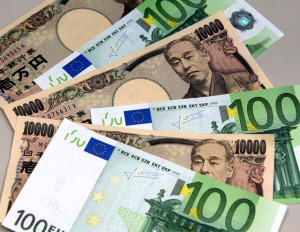 Friday’s trade saw EUR/JPY within the range of 144.26-145.88. The pair closed at 145.62, gaining 0.83% on a daily basis and 2.08% for the whole week.
Friday’s trade saw EUR/JPY within the range of 144.26-145.88. The pair closed at 145.62, gaining 0.83% on a daily basis and 2.08% for the whole week.
Fundamentals
Euro zone
Italian Balance of trade
The surplus on Italys trade balance probably contracted to EUR 1.5 billion in September, according to market expectations. Nations trade surplus rose 91.4% year-on-year to reach EUR 2.056 billion in August, as exports marked the first annual drop in nine months, while imports decreased the most in one year, due to lower energy purchases. Total exports fell at an annualized rate of 2.71% to EUR 24.07 billion in August, within which shipments of vehicles, excluding motor vehicles, dropped 14.0% and exports of agriculture, forestry and fishing products were 9.7% lower. Total imports decreased at a rate of 6.98% year-on-year to EUR 22 billion during the same month.
The trade balance, as an indicator, measures the difference in value between a country’s exported and imported goods during the reported period. It reflects the net export of goods, or one of the components to form the Gross Domestic Product. Generally, exports reflect how strong economic growth is, while imports indicate the strength of domestic demand. In case Italian trade surplus contracted more than anticipated, this might have a certain bearish effect on the single currency. The National Institute of Statistics (Istat) is to release the official trade data at 9:00 GMT on Monday.
Euro zone Balance of trade
The surplus on Euro areas trade balance probably expanded to EUR 10.0 billion in September, according to experts expectations, following a surplus figure of EUR 9.2 billion in the prior month. The latter has been the smallest surplus figure since January. In August 2013 the trade surplus was at the amount of EUR 7.3 billion. Total exports shrank at an annualized pace of 3% to EUR 140.5 billion in August, while total imports dropped 4% to reach EUR 131.3 billion.
The highest rates of increase in European Union exports were registered with China (11% during the period January-July compared to January-July 2013), South Korea (+10%) and the United States (+5%). As for EU28 imports, the largest increases were registered with South Korea (12% during the period January-July compared to the same period a year ago), Turkey (+7%), China (+6%) and Switzerland (+5%), according to the report by Eurostat released on October 16th.
Euro zones balance of trade produces regular surpluses mainly due to the high export of manufactured goods, such as machinery and vehicles. At the same time, the region is a net importer of energy and raw materials. Member states such as Germany, Italy, France and Netherlands play a key role in total trade.
In case the trade balance surplus expanded more than anticipated in September, this would certainly have a bullish impact on the euro. Eurostat is to publish the official trade data at 10:00 GMT.
Japan
Gross Domestic Product – preliminary estimate
Japans preliminary annualized GDP estimate probably showed a 2.1% growth during the third quarter of the year, according to the median forecast by experts. Nations economy contracted at an annualized rate of 7.1% in the second quarter, according to final data released on September 8th. This has been the most considerable annual drop since Q4 2008, when Japanese economy shrank at a rate of 15.2%.
On a quarterly basis, the preliminary GDP probably pointed to a 0.5% growth in Q3, according to expectations. In Q2 economy shrank 1.8%, according to the final estimate, down from a preliminary estimate of a 1.7% contraction, as the increase in the sales tax in April took a heavy toll on household spending, while business investment declined more than double the preliminary estimate. Private consumption, which comprises almost 60% of Japans economy, shrank 5.1% from a 5% drop in the preliminary estimate. This came as a result of the sales tax hike to 8% from 5% in April, while companies in the country were reluctant to allocate more capital spending, according to the report by Japans Cabinet Office. Private residential investment dropped 10.4% in the second quarter, from a preliminary 10.3% decrease, and business investment shrank 5.1% from a preliminary 2.5% drop.
Currency traders usually consider a higher rate of economic growth as a precursor to an interest rate hike. Higher interest rates will usually attract more investors, willing to purchase assets in the country, while, at the same time, this will increase demand for the local currency. Therefore, in case Japanese growth outstripped market expectations, this would have a bullish effect on the yen. The preliminary GDP data is due out at 23:50 GMT on Sunday (November 16th).
Sales tax speculation
Japanese Prime Minister Shinzo Abe is expected to speak at a news conference in the coming week, where he will probably announce a delay in the sales-tax hike, according to Mainichi newspaper. Abe will probably also explain the reasons behind his decision to dissolve the parliament, according to the same media. Japans Finance Minister Taro Aso said on Friday that an appropriate decision is to be made on raising the sales tax, given current economic conditions.
The debate on nations sales tax triggered a surge in the USD/JPY pair to fresh seven-year highs at 116.83 on Friday. At the same time, EUR/JPY touched highs unseen since January 2nd this year at 145.88.
”A sales tax delay and snap election is yen-negative,” said Derek Halpenny, the head of global-markets research at Bank of Tokyo-Mitsubishi in London, cited by Bloomberg. ”We’ve had swings to and fro in relation to that. If there’s a press conference and it’s confirmed, we’ll get a knee-jerk further move and perhaps we’ll test 117 but at those levels we could correct a little bit.”
Pivot Points
According to Binary Tribune’s daily analysis, the central pivot point for the pair is at 145.25. In case EUR/JPY manages to breach the first resistance level at 146.25, it will probably continue up to test 146.87. In case the second key resistance is broken, the pair will probably attempt to advance to 147.87.
If EUR/JPY manages to breach the first key support at 144.63, it will probably continue to slide and test 143.63. With this second key support broken, the movement to the downside will probably continue to 143.01.
The mid-Pivot levels for Monday are as follows: M1 – 143.32, M2 – 144.13, M3 – 144.94, M4 – 145.75, M5 – 146.56, M6 – 147.37.
In weekly terms, the central pivot point is at 144.51. The three key resistance levels are as follows: R1 – 146.99, R2 – 148.35, R3 – 150.83. The three key support levels are: S1 – 143.15, S2 – 140.67, S3 – 139.31.





